
Drone Incursions Expose Vulnerabilities in European Airspace
A recent surge in drone activity within restricted airspace across Europe has raised serious concerns about the continent's security infrastructure. Airports, in particular, are proving to be susceptible to these intrusions, prompting a critical examination of existing countermeasures and the development of more robust defense strategies.
The temporary closure of Aalborg Airport in northern Denmark due to unauthorized drone presence is just the latest incident in a series of disruptions affecting air travel. Similar drone sightings have been reported at other Danish airports, including Esbjerg, Sonderborg, and Skrydstrup. Skrydstrup, like Aalborg, also serves as a base for the Royal Danish Air Force, adding a layer of complexity to the security concerns. Copenhagen Airport, the nation's capital, also experienced a temporary flight suspension earlier this week due to drone activity.
The Danish Defense Minister, Troels Lund Poulsen, characterized the incidents as a potential "hybrid attack," suggesting a coordinated and deliberate effort rather than isolated occurrences. Justice Minister Peter Hummelgaard has stated that all possibilities are being considered in the ongoing investigation into the source of these drone incursions.
While a direct link to Russia remains unconfirmed in the Danish incidents, similar drone activity in Eastern Europe has prompted a strong response from NATO. Following reports of Russian drones entering Polish airspace in early September, NATO Secretary-General Mark Rutte announced the launch of "Eastern Sentry," a new operation designed to bolster the alliance's eastern defenses.
The challenge for Danish authorities, and indeed for many across Europe, lies in the difficulty of identifying and neutralizing drones, particularly within the complex environment of an airport.
The Growing Accessibility of Drone Technology
Drones, including unmanned combat aerial vehicles, have been a part of military operations since the 1970s. They have become increasingly prominent in modern conflicts, such as the war in Ukraine. However, the rapid advancement and affordability of drone technology in the commercial market have significantly altered the landscape.
Richard Gill, founder and CEO of a security firm specializing in drone defense, highlights the increasing accessibility of drones. He explains that the combination of lower prices and ease of use means that individuals can now create sophisticated drone capabilities with resources that were once limited to advanced military organizations.
This poses a significant challenge for airports, which are responsible for maintaining strict control over their airspace. Jukka Savolainen from The European Center of Excellence for Countering Hybrid Threats (Hybrid CoE), emphasizes that any drone activity above airports will inevitably lead to the suspension of air traffic, as no risk to aviation security can be tolerated.
This zero-tolerance approach, which has resulted in airport shutdowns worldwide, from major hubs like New York, London, Dubai and Frankfurt, means that individuals with malicious intent, or even hobbyists who inadvertently stray into restricted areas, can cause major disruptions.
Why Shooting Down Drones Isn't a Simple Solution
While the military routinely engages and destroys drones in combat situations, the same approach is difficult to implement in civilian airspace. Even if security agencies suspect malicious intent, it is often impossible to determine whether a drone is a military asset or a recreational device before it disappears from sight. Even when the nature of the drone can be determined, there are still significant safety concerns.
Savolainen from Hybrid CoE explains that hitting a drone with projectiles is difficult, requiring a large number of shots to ensure a successful hit. Moreover, most projectiles will fall back to earth after being fired, making this approach unsuitable for densely populated areas unless the drone poses an immediate and dangerous threat.
The difficulty of assessing the threat from a distance, coupled with the proximity of airports to residential areas, makes the potential for collateral damage a major deterrent. The costs associated with shooting down a drone, and the fact that commercial airports have no legal basis to do so, make it an impractical solution. Gill also points out that the rapid pace of drone development has outstripped legislation, leaving airports vulnerable.
Many airports lack the detection systems required to fully understand drone activity. They often rely on ground personnel, security staff, or other employees to report sightings. Responding to these sightings, particularly with lethal force, raises complex legal and practical questions.
Alternative Drone Defense Strategies
Unlike military or dual-use air bases, commercial airports, particularly those with limited resources, have few options available to them. Identifying drones through radio frequency analysis, video transmissions, radar, or security cameras are among the preventative measures currently available. However, intercepting drones, even after they have been identified, remains a major challenge.
As a result, suspending operations is often the initial response when drones are detected in unauthorized areas.
There are an increasing number of products designed to counter drones, both for commercial and military applications. However, upgrading airport defense systems is an expensive undertaking that requires constant investment to keep pace with technological advancements.
Ryanair CEO Michael O'Leary has argued that governments should be responsible for funding drone defense, describing it as a national security issue rather than an airport responsibility.
The EU appears to share this view. European Commission President Ursula von der Leyen announced plans to "build a drone wall" to address the threat of drone incursions into sovereign airspace.
Dubbed Eastern Flank Watch, this initiative will involve Poland, Finland, Estonia, Latvia, and Lithuania and will focus on strengthening defenses along the EU's eastern borders. While details remain limited, the "drone wall" is expected to utilize similar detection and interception measures as those available to airports, but with the added capability of taking down threatening drones. It is also expected to be more cost-effective than current air defense systems, which are designed to counter conventional aircraft and missiles.
Von der Leyen has emphasized that this is a concrete plan and a fundamental element of a credible defense strategy.

No comments:
Post a Comment